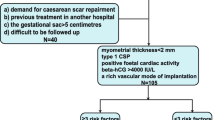Abstract
Background
The effectiveness and safety of pituitrin injection coupled with hysteroscopy and suction curettage as treatment for type I cesarean scar pregnancy (CSP) have not been studied enough in the literature, by comparing it to uterine artery embolization (UAE) followed by suction curettage we aim to determine its efficacy.
Materials and Methods
Data of 53 patients (the PIT group) with type I CSP treated with pituitrin injection combined with hysteroscopic suction curettage and 137 patients (the UAE group) with type I CSP treated with UAE followed by suction curettage were collected in retrospect. The clinical data were analyzed statistically to compare the efficacy and safety between the two groups.
Results
The PIT group had a shorter duration of postoperative vaginal bleeding, postoperative hospitalization, and overall hospitalization length (P < 0.05). The PIT group had lower overall hospitalization costs and a lower rate of adverse events than the UAE group (P < 0.05). There was no significant difference between the two groups in terms of treatment success rate, the average length of operation, blood loss during the procedure, time when serum β-hCG returned to normal range, and menstrual recovery time after hospital release (P > 0.05).
Conclusion
UAE and pituitrin injection followed by hysteroscopic suction curettage are good choices for type I CSP treatment. However, pituitrin injection with hysteroscopic suction curettage outperforms UAE followed by suction curettage. Thus, pituitrin injection may be an option of high priority for type I CSP.
Similar content being viewed by others
References
Gonzalez N, Tulandi T. Cesarean scar pregnancy: a systematic review. J Minim Invasive Gynecol. 2017;24(5):731–8. https://doi.org/10.1016/j.jmig.2017.02.020.
Mohapatra I, Samantray SR. Scar ectopic pregnancy: an emerging challenge. Cureus. 2021;13(7):e16673. https://doi.org/10.7759/cureus.16673.
Feng XL, Xu L, Guo Y, et al. Factors influencing rising caesarean section rates in China between 1988 and 2008. Bull World Health Organ. 2012;90(1):30–9. https://doi.org/10.2471/BLT.11.090399.
Shafqat G, Khandwala K, Iqbal H, et al. Cesarean scar pregnancy: an experience of three cases with review of literature. Cureus. 2018;10(2):e2133. https://doi.org/10.7759/cureus.2133.
Gao L, Huang Z, Gao J, et al. Uterine artery embolization followed by dilation and curettage within 24 hours compared with systemic methotrexate for cesarean scar pregnancy. Int J Gynaecol Obstet. 2014;127(2):147–51. https://doi.org/10.1016/j.ijgo.2014.05.005.
Giampaolino P, De Rosa N, Morra I, et al. Management of cesarean scar pregnancy: a single-institution retrospective review. Biomed Res Int. 2018. https://doi.org/10.1155/2018/6486407.
Lin SY, Hsieh CJ, Tu YA, et al. New ultrasound grading system for cesarean scar pregnancy and its implications for management strategies: an observational cohort study. PLoS ONE. 2018;13(8):e0202020. https://doi.org/10.1371/journal.pone.0202020.
Karlsen K, Hrobjartsson A, Korsholm M, et al. Fertility after uterine artery embolization of fibroids: a systematic review. Arch Gynecol Obstet. 2018;297(1):13–25. https://doi.org/10.1007/s00404-017-4566-7.
Wu Y, Zhou L, Chen L, et al. Efficacy of contrast-enhanced ultrasound for diagnosis of cesarean scar pregnancy type. Medicine (Baltimore). 2019;98(44):e17741. https://doi.org/10.1097/MD.0000000000017741.
Pędraszewski P, Wlaźlak E, Panek W, et al. Cesarean scar pregnancy: a new challenge for obstetricians. J Ultrason. 2018;18(72):56–62. https://doi.org/10.15557/JoU.2018.0009.
Pokhrel M, Acharya SP, Sharma J, et al. Scar pregnancy a diagnostic conundrum: a case report. JNMA J Nepal Med Assoc. 2021;59(235):288–91. https://doi.org/10.31729/jnma.5202.
Long Y, Zhu H, Hu Y, et al. Interventions for non-tubal ectopic pregnancy. Cochrane Database Syst Rev. 2020;7(7):CD011174. https://doi.org/10.1002/14651858.CD011174.pub2.
Feng Y, Chen S, Li C, et al. Curettage after uterine artery embolization combined with methotrexate treatment for caesarean scar pregnancy. Exp Ther Med. 2016;12(3):1469–75. https://doi.org/10.3892/etm.2016.3489.
Kwasniewska A, Stupak A, Krzyzanowski A, et al. Cesarean scar pregnancy: uterine artery embolization combined with a hysterectomy at 13 weeks’ gestation–a case report and review of the literature. Ginekol Pol. 2014;85(12):961–7. https://doi.org/10.17772/gp/1890 (PMID: 25669068).
Timor-Tritsch IE, Monteagudo A. Unforeseen consequences of the increasing rate of cesarean deliveries: early placenta accreta and cesarean scar pregnancy. A Rev Am J Obstet Gynecol. 2012;207(1):14–29. https://doi.org/10.1016/j.ajog.2012.03.007.
Agarwal N, Gainder S, Chopra S, et al. The management of scar ectopic: a single-center experience. Cureus. 2021;13(6):e15881. https://doi.org/10.7759/cureus.15881.
Tan G, Xiang X, Guo W, et al. Study of the impact of uterine artery embolization (UAE) on endometrial microvessel density (MVD) and angiogenesis. Cardiovasc Intervent Radiol. 2013;36(4):1079–85. https://doi.org/10.1007/s00270-013-0599-x.
Vendittelli F, Savary D, Storme B, et al. Ovarian thrombosis and uterine synechiae after arterial embolization for a late postpartum haemorrhage. Case Rep Womens Health. 2014;22(5):1–4. https://doi.org/10.1016/j.crwh.2014.10.001.
Qian ZD, Weng Y, Du YJ, et al. Management of persistent caesarean scar pregnancy after curettage treatment failure. BMC Pregnancy Childbirth. 2017;17(1):208. https://doi.org/10.1186/s12884-017-1395-4.
Saha MM, Biswas SC, Alam H, et al. Assessment of blood loss in abdominal myomectomy by intramyometrial vasopressin administration versus conventional tourniquet application. J Clin Diagn Res. 2016;10(5):QC10–3. https://doi.org/10.7860/JCDR/2016/17484.7789.
Chudnoff S, Glazer S, Levie M. Review of vasopressin use in gynecologic surgery. J Minim Invasive Gynecol. 2012;19(4):422–33. https://doi.org/10.1016/j.jmig.2012.03.022.
Wang J, Zhao R, Qian H, et al. Pituitrin local injection versus uterine artery embolization in the management of cesarean scar pregnancy: a retrospective cohort study. J Obstet Gynaecol Res. 2021;47(5):1711–8. https://doi.org/10.1111/jog.14720.
Acknowledgements
The authors would like to thank the Jiangsu Province Health Department, Project of Social Women Affairs Section, who funded this research under grant number F201921.
Author information
Authors and Affiliations
Corresponding author
Ethics declarations
Conflict of interest
The authors declare no conflict of interest.
Ethical Standard
The study was approved by the institutional local ethics committee of Jiangsu Province Hospital (2019-NT-24) and informed consent was also obtained from the patients.
Additional information
Publisher's Note
Springer Nature remains neutral with regard to jurisdictional claims in published maps and institutional affiliations.
Rights and permissions
Springer Nature or its licensor (e.g. a society or other partner) holds exclusive rights to this article under a publishing agreement with the author(s) or other rightsholder(s); author self-archiving of the accepted manuscript version of this article is solely governed by the terms of such publishing agreement and applicable law.
About this article
Cite this article
Rahman, J., Qiu, Y., Yuan, X. et al. Pituitrin Injection before Hysteroscopic Curettage for Treating Type I Cesarean Scar Pregnancy in Comparison with Uterine Artery Embolization: A Retrospective Study. J Obstet Gynecol India 73, 229–234 (2023). https://doi.org/10.1007/s13224-022-01724-w
Received:
Accepted:
Published:
Issue Date:
DOI: https://doi.org/10.1007/s13224-022-01724-w




